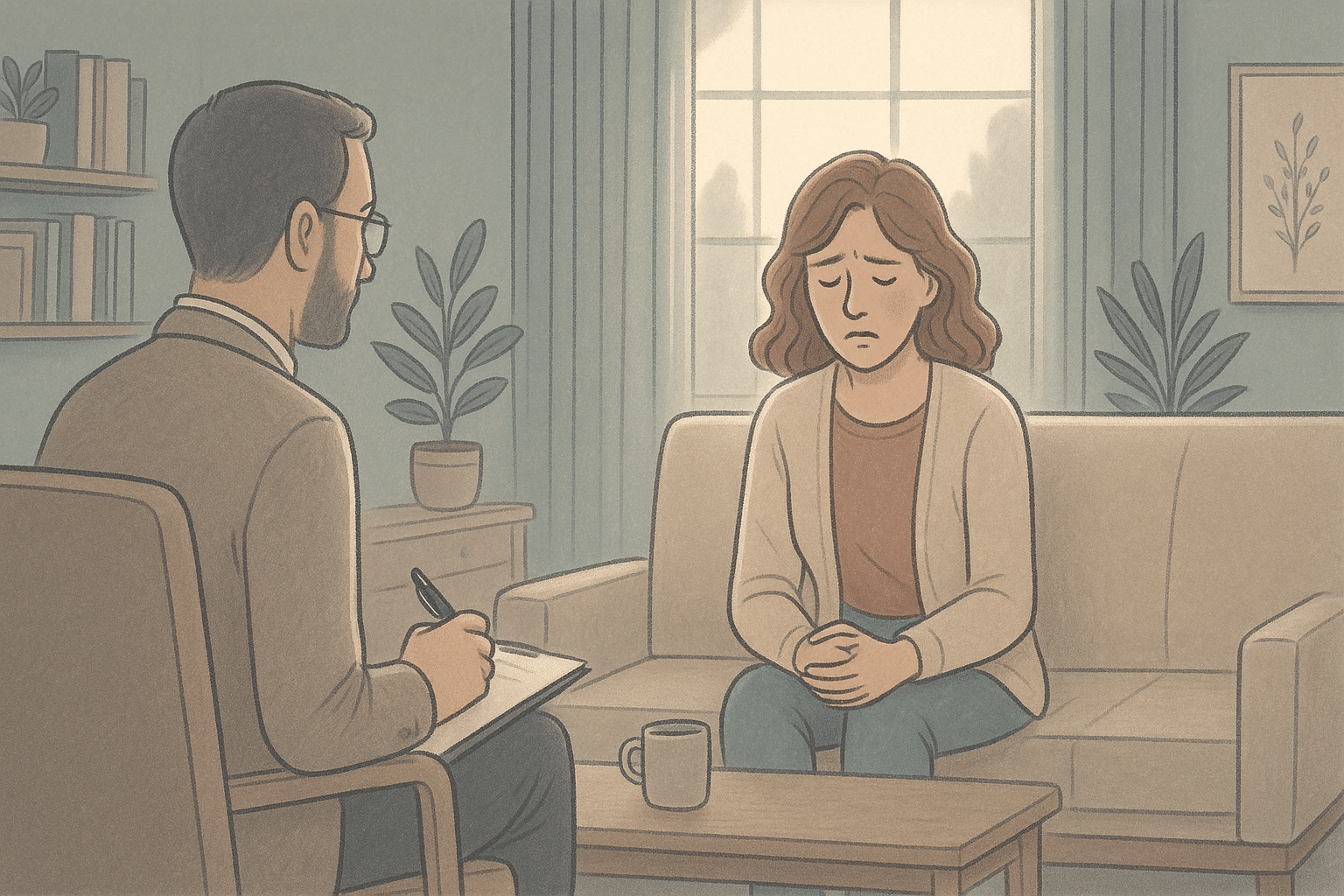Key Takeaways
- Anhedonia is the inability to feel pleasure and is often a symptom of depression, but not always.
- Depression is a broader mental health condition that includes a range of emotional and physical symptoms.
- You can experience depression without anhedonia, and vice versa.
- Understanding the differences can help in choosing the appropriate treatment and support.
- Professional assessment is essential for accurate diagnosis and effective treatment.
- A Mission For Michael (AMFM) offers comprehensive mental health therapy, treatment, and counseling programs for depression and anhedonia across multiple locations in California, Minnesota, and Virginia, to make treatment accessible.
Differences Between Anhedonia and Depression
At first glance, anhedonia and depression might seem like two sides of the same coin. However, they are distinct in nature and impact. Recognizing these differences can be the first step toward effective treatment and improved mental well-being.
Anhedonia Basics
Anhedonia is defined as the inability to experience pleasure from activities that typically bring joy. Imagine being unable to feel excitement from a favorite hobby or joy from spending time with loved ones—this is anhedonia at work. It’s a core symptom of depression but can also exist independently, affecting one’s quality of life profoundly.
Depression Overview
Depression, on the other hand, is a complex mental health disorder characterized by persistent feelings of sadness, hopelessness, and a lack of interest in daily activities.

Depression is more than feeling blue; it’s a condition that can affect one’s ability to function in everyday life.
Depression encompasses a variety of symptoms, including fatigue, changes in appetite, and sleep disturbances, alongside emotional challenges.
Distinctive Features
While anhedonia is often a symptom of depression, not everyone with depression experiences anhedonia. Similarly, someone can have anhedonia without meeting the full criteria for depression. Understanding these differences helps customize interventions to address specific needs, whether it’s reigniting the capacity for joy or tackling the broader symptoms of depression.
| A Mission For Michael: Expert Mental Health Care Founded in 2010, A Mission For Michael (AMFM) offers specialized mental health care across Southern California, Minnesota, and Virginia. Our accredited facilities provide residential and outpatient programs, utilizing evidence-based therapies such as CBT, DBT, and EMDR. Our dedicated team of licensed professionals ensures every client receives the best care possible, supported by accreditations from The Joint Commission and the California Department of Health Care Services. We are committed to safety and personalized treatment plans. Start your recovery journey with AMFM today! |
Symptoms and Indicators
Overlapping Symptoms of Depression and Anhedonia
Both anhedonia and depression share some overlapping symptoms, which can sometimes make it challenging to differentiate between the two. Common symptoms include:
- Persistent sadness or low mood
- Lack of interest in activities once enjoyed
- Changes in appetite or weight
- Sleep disturbances
- Fatigue or loss of energy
These symptoms can vary in intensity and duration, impacting one’s ability to function in daily life.
Unique Signs of Anhedonia

What sets anhedonia apart is its focus on pleasure and enjoyment.
Individuals with anhedonia specifically struggle with feeling pleasure, even from activities they used to love. This can manifest as:
- Lack of excitement for future events
- Feeling emotionally flat or numb
- Reduced interest in social interactions
These signs highlight the emotional disconnect that anhedonia creates, making it a unique mental health challenge.
Depression-Specific Indicators
Depression has its own set of indicators that may not necessarily overlap with anhedonia. These include:
- Persistent feelings of worthlessness or guilt
- Recurrent thoughts of death or suicide
- Physical symptoms, such as headaches or digestive issues, without a clear cause
- Significant changes in mood or emotional regulation
Underlying Causes
Factors Contributing to Anhedonia
Anhedonia doesn’t appear out of nowhere—several factors can contribute to its development. Biological elements such as neurotransmitter imbalances, particularly in dopamine, play a significant role. Dopamine aids in experiencing pleasure and reward. When its pathways are disrupted, the ability to feel joy can diminish.
Psychological factors also contribute. Experiences of chronic stress, trauma, or significant life changes can trigger anhedonia. These experiences might alter brain function over time, leading to difficulties in feeling pleasure.
Also, lifestyle factors like social isolation and lack of physical activity can exacerbate anhedonia. Being cut off from social networks or not engaging in activities that stimulate the mind and body can deepen feelings of detachment and numbness.
Root Causes of Depression
Depression, like anhedonia, is influenced by multiple factors. Individuals with a familial history of depression are at an increased risk of developing the disorder. Biochemically, imbalances in neurotransmitters such as serotonin, norepinephrine, and dopamine are also frequently associated with the onset of depression.
Additionally, environmental stressors, including the loss of a loved one, financial challenges, or exposure to high-stress environments, can act as triggers that worsen depressive symptoms. These factors often interact in complex ways, making each individual’s experience of depression unique.
Diagnosis and Assessment
Evaluating Anhedonia
To evaluate anhedonia, mental health professionals often use structured interviews and self-report questionnaires. These tools help identify the extent to which an individual experiences a lack of pleasure. Questions might gauge interests in hobbies, social interactions, and emotional responses to positive events.
Additionally, clinicians might assess for related conditions like depression or anxiety, as these can influence the presence and severity of anhedonia.
Depression Diagnosis
Diagnosing depression involves more than just identifying symptoms. Clinicians look at the duration, frequency, and impact of symptoms on daily life. A detailed history of mental health, family background, and current stressors is essential.
Standardized diagnostic criteria, such as those outlined in the DSM-5 (Diagnostic and Statistical Manual of Mental Disorders, Fifth Edition), guide the process. These criteria ensure a consistent and reliable diagnosis, which is critical for developing an effective treatment plan.
Professional Assessment Methods
Professional assessment methods include clinical interviews, psychological testing, and sometimes medical evaluations to rule out physical causes of symptoms. Mental health professionals might use tools like the Beck Depression Inventory or the Hamilton Rating Scale for Depression to quantify the severity of symptoms.
These assessments help in diagnosing and in tracking progress over time. Regular evaluations can inform treatment adjustments, ensuring that interventions remain effective and responsive to the individual’s needs.
Treatment Options
Treatment for Anhedonia
Treating anhedonia often involves psychotherapy, such as Cognitive Behavioral Therapy (CBT), which can help individuals re-engage with activities and challenge negative thought patterns. Behavioral activation, a component of CBT, encourages involvement in activities that can increase positive experiences and emotions.
In some cases, medications that target dopamine pathways may be considered, although their effectiveness can vary. Work closely with a healthcare provider to find the most suitable treatment.
Managing Depression
Depression management typically involves a combination of medication and therapy. Antidepressants, such as selective serotonin reuptake inhibitors (SSRIs), are commonly prescribed to help balance neurotransmitter levels.
Therapies like CBT and interpersonal therapy (IPT) are effective in addressing the cognitive and social aspects of depression. These therapies equip individuals with tools to manage symptoms and improve their quality of life.
Integrated Approaches
Integrated treatment approaches recognize the interplay between anhedonia and depression. Combining therapies with lifestyle interventions, such as regular exercise, healthy eating, and social support, can enhance treatment outcomes.

Running is a powerful tool against depression and anhedonia, as it boosts endorphin levels and improves mood.
Mindfulness practices and stress-reduction techniques, like meditation and yoga, can also support mental health by promoting relaxation and emotional resilience. These strategies empower individuals to take an active role in their recovery journey.
Choose AMFM for Comprehensive Anhedonia or Depression Treatment
Understanding the differences between anhedonia and depression is essential for anyone managing mental health challenges. While anhedonia—the inability to feel pleasure—is often a symptom of depression, it can exist independently and requires specific treatment approaches. At AMFM, we recognize that effective treatment begins with accurate diagnosis.
Our comprehensive depression therapy programs are customized to address both conditions through evidence-based approaches like Cognitive Behavioral Therapy (CBT), medication management, and specialized treatments such as Transcranial Magnetic Stimulation (TMS).

With multiple locations across California, Virginia, and Washington, we strive to make our treatment accessible through various insurance plans, payment options, and sliding-scale fees.
Don’t let anhedonia or depression control your life. Our professional team at AMFM is ready to help you understand your symptoms, develop effective coping strategies, and guide you toward recovery.
Contact us today for a confidential assessment and take your first step toward reclaiming joy and emotional well-being.
Frequently Asked Questions (FAQ)
Can anhedonia occur without depression?
Yes, anhedonia can occur without depression. While it’s a core symptom of depression, it can also be present in other mental health disorders, such as schizophrenia, or occur on its own due to other factors like chronic stress or substance abuse.
Is anhedonia treatable?
Yes, anhedonia is treatable. Treatment typically involves a combination of therapy, medication, and lifestyle changes. Cognitive-behavioral therapy (CBT) and behavioral activation are effective in addressing the emotional and cognitive aspects of anhedonia.
How long can depression last without treatment?
Depression can last for weeks, months, or even years if left untreated. The duration varies depending on the individual and the severity of the condition. Chronic depression can have a significant impact on one’s quality of life and daily functioning.
Are children affected by anhedonia?
Yes, children can experience anhedonia, although it may manifest differently than in adults. They might show a lack of interest in play or social activities and may seem withdrawn or emotionally flat. Early intervention is crucial for children, as untreated anhedonia can affect their development and social interactions.
What depression treatment programs does AMFM offer?
AMFM offers several levels of care for depression, including Partial Hospitalization Programs (PHPs), Intensive Outpatient Programs (IOPs), and standard outpatient therapy. These options provide various levels of support customized to your specific needs, from intensive daily treatment to flexible schedules that allow you to maintain your normal routine.











